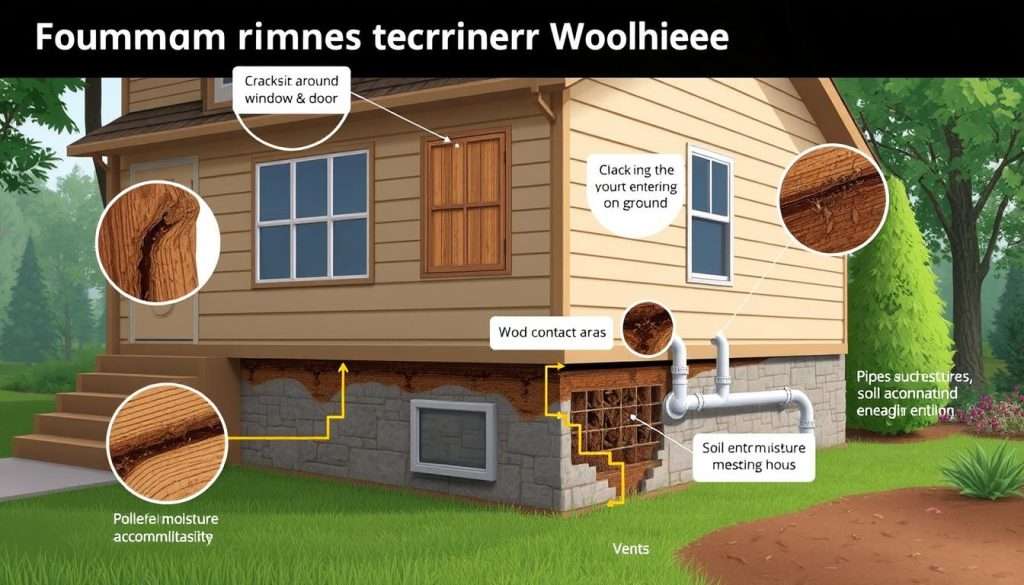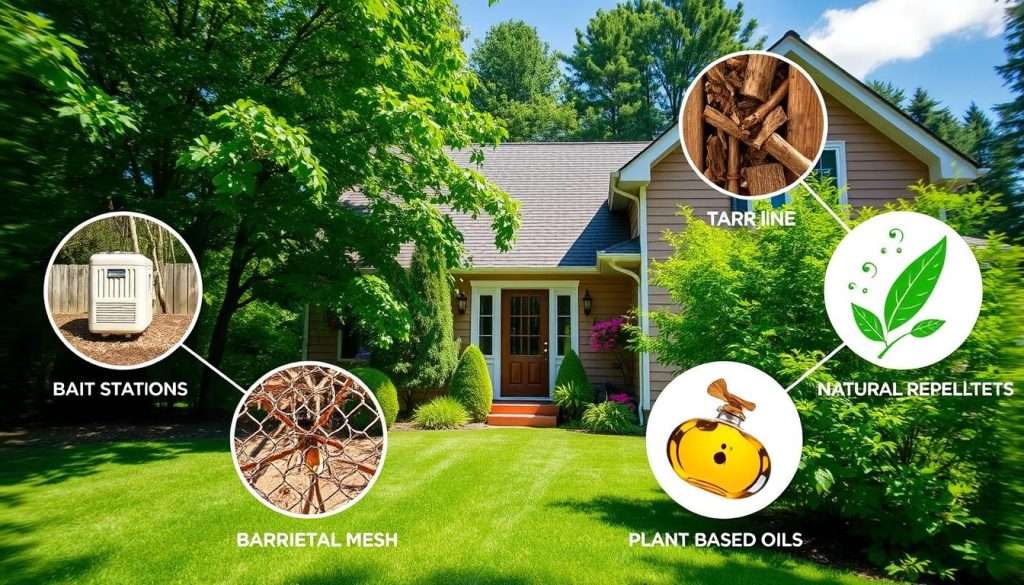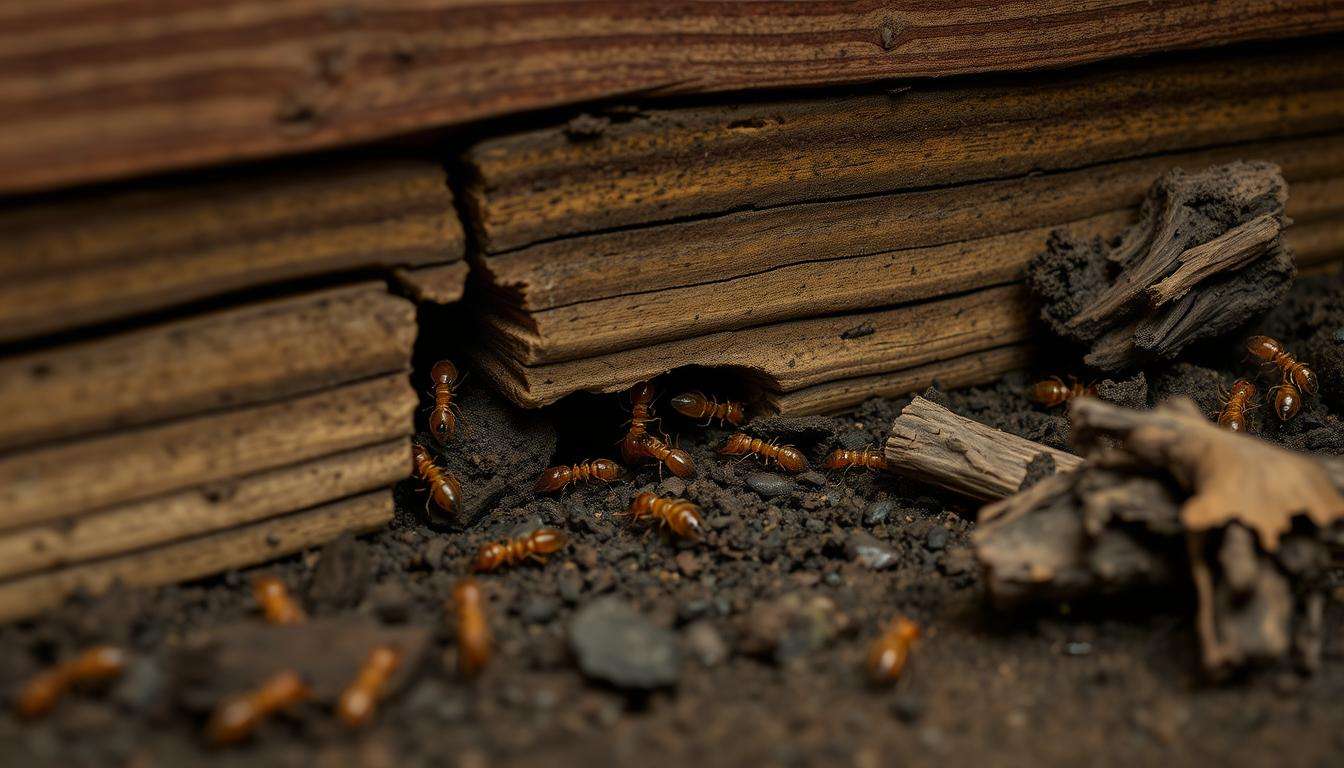It’s key to know how termites get into your home to protect it. A termite infestation can cause a lot of damage, with over $5 billion lost each year in the U.S. These pests can sneak in through tiny cracks, as small as 1/32 of an inch. By spotting common entry points and taking steps to prevent them, you can lower the risk of an infestation.
Signs of termite infestation might be hard to spot but can cause big damage over time. To stop termites from getting in, it helps to know how they get into your home. For example, homes with siding that touches the ground and those built on slabs are more at risk. We urge you to take these tips to heart, as being proactive can save your home.
In this guide, we’ll give you tips and advice to keep termites away. We want to help you keep your home safe and sound.
Key Takeaways
- Termite workers can enter through cracks as small as 1/32 of an inch.
- Subterranean termites commonly build mud tubes to gain access to structures.
- Moisture control is critical in preventing termite infestations.
- Wood-to-ground contact increases the risk of termite entry.
- Annual termite inspections are vital for early detection of infestations.
Understanding Termite Behavior
Learning about termite behavior is key to stopping them. Knowing the types of termites in the U.S., their life cycle, and how they sneak into homes is crucial. This knowledge helps you protect your property with the right termite treatments.
Types of Termites Commonly Found in the U.S.
There are about 45 types of termites in the U.S. Subterranean and drywood termites are the most common. Subterranean termites can live in many places and are cold-tolerant. Drywood termites like the warmer south.
- Subterranean Termites: These termites can destroy a lot. They live in big colonies with millions of termites. They are common in California and other places.
- Drywood Termites: Found in the southern U.S., they live in dry wood. They don’t need soil to survive.
Lifecycle and Reproduction of Termites
The termite life cycle includes egg, nymph, and adult stages. Queens can lay thousands of eggs every day for up to ten years. This means colonies can grow big before anyone notices.
How Termites Infest Homes Undetected
Termites are sneaky. They can damage homes a lot without anyone knowing. They make hidden tunnels in walls or under floors. This makes it hard to find them until it’s too late. Getting rid of termites early is important to avoid big problems.
How Do Termites Get In Your House
It’s important to know how termites get into your house. They can damage your home a lot if they get in. Knowing where termites usually enter can help you protect your home.
Common Entry Points for Termites
Termites are good at finding ways into homes. Here are some common places they enter:
- Cracks in the foundation and walls
- Gaps around utilities and vents
- Wood-to-ground contact areas, such as doorframes and deck posts
- Moisture-damaged wood that provides easy access
Sealing these spots can lower the chance of termites getting in. Since moisture attracts termites, fixing these issues is key.
Swarmers and Their Role in Infestations
Swarmer termites are the ones that start new colonies. They fly around looking for places to start new homes. Their small size lets them get into tiny holes, making it hard to stop them.
Once inside, they lose their wings and start a new colony. This is how termites can get into your house.

To learn more about keeping termites out, check out these effective tips. Being careful about these things can help keep your home termite-free.
Signs of a Termite Infestation
Spotting termite signs early is key to protecting your home. Certain signs can warn you of termites, letting you act fast. Knowing these signs helps keep your home safe.
Identifying Mud Tubes and Swarmers
Mud tubes are a big sign of termites. They look like thin tubes on walls. If you see them, termites are moving around.
Swarmers are another sign. These termites look for mates and can be seen near windows. Seeing them means a big colony is nearby. For more info, check this resource.
Signs of Wood Damage and Hollow Sounds
Wood damage is a clear sign. If wood sounds hollow, termites might be there. Look for pinholes, sunken lines, or bubbly paint too.
Also, watch for frass, which is drywood termite pellets. Sagging floors or ceilings are bad signs too. Spotting these signs early can save you a lot of trouble. Always be on the lookout and act fast.
Preventing Termite Entry
It’s important to protect your home from termites. Ignoring prevention can cause expensive damage. Keeping wood off the ground and controlling moisture are key steps.
Importance of Maintaining Wood-to-Ground Clearance
Wood touching the ground makes it easy for termites to get in. Make sure wood is at least six inches off the ground. This helps keep termites out of your home.
Moisture Control and Its Role in Prevention
Too much moisture attracts termites. Keeping moisture levels down makes your home less appealing to them. Here are some tips:
- Make sure gutters work well to avoid water pooling.
- Fix leaks in plumbing and irrigation to reduce moisture around foundations.
- Improve ventilation in crawl spaces to lower humidity.
These steps help control moisture and protect your home from termites.
Regular Termite Inspections
Getting regular termite checks is key to keeping your home pest-free. These steps help spot problems early. They also give you peace of mind. Knowing about termite issues early can save a lot of money.
Benefits of Scheduling Annual Inspections
Annual checks have many advantages:
- They catch termite problems early, saving your home from big damage.
- They show where your home might be weak, like moisture spots or structural issues.
- They find signs of past termite problems, like wood damage and mud tubes.
- They offer treatment plans based on what the inspector finds.
What to Expect During a Termite Inspection
Knowing what happens during a termite check can make it easier. Here’s what usually happens:
- Inspectors look at easy-to-see spots, like cracks in the foundation and joints.
- They check hidden spots, like crawl spaces and attics. Make sure these areas are clear.
- They search for termite signs, like hollow wood, frass, and wings.
- If they find any problems, they suggest how to fix them.
In California, companies like MightyMite Termite Services use green methods for checks and treatments. This helps keep your home safe from termites without breaking the bank.
Effective Termite Control Methods
Termite infestations can be a big problem for your home. Using different termite control methods can help. Knowing these methods can help you fight these pests well.
Professional Treatment Options
For serious termite problems, many turn to professional help. Liquid termiticides are used a lot in places like Mississippi. They can last 8 to 12 years or more. Ingredients like Fipronil and Imidacloprid are common.
- Fipronil
- Imidacloprid
- Chlorantraniliprole
- Permethrin
- Cypermethrin
- Bifenthrin
Foam termiticides can also be used. They have ingredients like fipronil and imidacloprid. These strong solutions are often needed to protect your home.
DIY Methods and Their Limitations
Some people try DIY termite control to save money. But, these methods might not work well. They can’t always reach the termites’ colonies.
- DIY methods may not reach colonies effectively.
- Inadequate solutions may lead to larger infestations over time.
- Homeowners might overlook crucial areas requiring treatment.
This shows why you need a mix of DIY and professional help. This way, you get the best results.
Using Baiting Systems and Monitoring Stations
Baiting systems are a good way to fight termites. They work well when set up right. These systems slowly kill the termites, destroying their colony.
Monitoring stations can warn you early about termites. This lets you act fast. Using baiting systems with barriers can really help protect your home.

Termite Damage Repair
It’s key to know how to fix termite damage to keep your home safe and strong. Homeowners often face big challenges when figuring out the damage and how to fix it. The damage can be small or very big, needing different fixes and budgets.
Assessing and Repairing Structural Damage
First, check for termites. Look closely at damaged areas and important parts of your home. Fixing sagging floors might mean replacing rotten wood, costing $1,500 to $5,000 per beam. Other fixes include:
- Patching drywall holes: $60–$200 each
- Fixing sagging subfloors: $300 per square foot
- Repairing wall discoloration from termites: $2–$6 per square foot
Small fixes might cost $250 to $1,000. But bigger problems can cost $3,000 to $10,000 or more.
Cost Considerations for Repairs
When planning repairs, think about the cost of fixing and treating for termites. Most treatments last five years. But, bad infestations might need more treatments, even in six months. Insurance usually doesn’t cover termite damage, so regular checks and treatments are important.
Here’s a quick guide on what repairs might cost:
| Repair Type | Cost Range |
|---|---|
| Replacing Wooden Beams | $1,500 – $5,000 each |
| Patching Drywall Holes | $60 – $200 each |
| Fixing Sagging Floors | $300 per square foot |
| Wall Discoloration Fixes | $2 – $6 per square foot |
| Small-Scale Repairs | $250 – $1,000 |
| Medium-Scale Repairs | $1,000 – $3,000 |
| Extensive Repairs | Starting at $3,000 |
Conclusion
Knowing how termites get into your home and spotting signs of infestation are key. Keeping wood away from your home and controlling moisture in crawlspaces helps a lot. Regular checks, by pros or you, can find termites early.
Using gutters right and covering crawlspaces with plastic helps your home stay strong. But, be careful with mulch to avoid touching wood. Keeping up with home care is vital to keep termites away.
By following the tips in this article, you can keep your home safe from termites. This makes your home strong and safe for many years. Taking action now is important for a healthy home.
